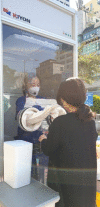Innovative screening tests for COVID-19 in South Korea
- PMID: 32295319
- PMCID: PMC7348672
- DOI: 10.15441/ceem.20.032
Innovative screening tests for COVID-19 in South Korea
Abstract
Recently, the number of Corona Virus Disease 2019 (COVID-19) cases has increased remarkably in South Korea, so the triage clinics and emergency departments (ED) are expected to be overcrowded with patients with presumed infection. As of March 21st, there was a total of 8,799 confirmed cases of COVID-19 and 102 related deaths in South Korea that was one of the top countries with high incidence rates [1]. This sharp increase in infection is associated with 1) outbreaks in individual provinces, 2) deployment of rapid and aggressive screening tests, 3) dedicated healthcare staffs for virus screening tests, 4) quarantine inspection data transparency and accurate data reporting, and 5) public health lessons from previous Severe Acute Respiratory Syndrome (SARS) and Middle East Respiratory Syndrome (MERS) outbreaks. This commentary introduces innovative screening tests that are currently used in South Korea for COVID-19, e.g., Drive-Through and Walk-Through tests, and compare the advantages and disadvantages of both methods.
Keywords: COVID-19 diagnostic testing; Early Detection of Disease; Infectious Disease Outbreak; Virus Diseases.
Figures



References
-
- Korean Centers for Disease Control and Prevention Current statistics of COVID-19 in Korea. http://ncov.mohw.go.kr/bdBoardList_Real.do?brdId=1&brdGubun=13&ncvContSe.... Updated 2020. Accessed March 21, 2020.
-
- Weiss EA, Ngo J, Gilbert GH, Quinn JV. Drive-through medicine: a novel proposal for rapid evaluation of patients during an influenza pandemic. Ann Emerg Med. 2010;55:268–73. - PubMed
-
- World Health Organization Rational use of personal protective equipment for coronavirus disease 2019 (COVID-19). Interim guiance 27 February 2020. https://apps.who.int/iris/bitstream/handle/10665/331215/WHO-2019-nCov-IP.... Updated 2020. Accessed March 21, 2020.
-
- Gust ID, Hampson AW, Lavanchy D. Planning for the next pandemic of influenza. Rev Med Virol. 2001;11:59–70. - PubMed
Grants and funding
LinkOut - more resources
Full Text Sources
Research Materials
Miscellaneous

